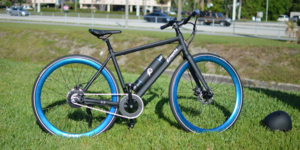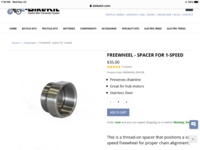FlatSix911
Well-Known Member
- Region
- USA
- City
- Silicon Valley
A good option if you need an around-town cruiser for basic shopping and flatland commuting under $999. 

 electrek.co
electrek.co
I’ve spent more than a decade working in the e-bike industry, and so I’ve seen my fair share of the latest electric bicycle trends.
One I didn’t expect to see this year though was the rise of single-speed electric bicycles. But ready or not, here they come. And they’re bringing lower prices with them!
A big reason for the lower price of many single-speed electric bicycles is simply the reduction in parts. Shifters, derailleurs, and transmission cables all add cost and complexity that can be removed on single-speed e-bikes. They even simplify issues like packaging and shipping, since there is no need to protect fragile transmission parts. And one of the most common places for damage on an e-bike in shipping is a banged-up derailleur — so avoiding that helps cut costs associated with returns and replacements. And when you consider the markup that goes into an electric bike, removing just $30-$50 in shifters, cables, derailleurs, derailleur hangers, guards, cassettes, and other related parts can mean shaving off several times that much on the bike’s MSRP.
This summer the company released their latest even lower priced e-bike, the RadMission. That e-bike, as you might have guessed by now, is also a single-speed e-bike. It debuted at a promotional $999 before leveling off at $1,099. Both the RadRunner and RadMission also saved a few dollars here and there with other measures, such as rigid forks and simplified displays. But their single-speed designs weren’t outliers in the industry. Other companies quickly followed suit.
Ride1Up recently unveiled its own single-speed Roadster V2 e-bike priced at an impressive $995. The price is even more impressive when you consider that the bike also includes a belt drive instead of a chain drive! We’ve also seen other popular sub-$1k single-speed e-bikes come along such as the Propella single-speed e-bike and the Analog Motion AM1.
Both of those bikes also demonstrate another advantage of single-speed e-bikes: a chance to reduce weight. Both bikes weigh under 35 lb (15.8 kg), which makes them veritable featherweights in the world of e-bikes.


Single-speed electric bikes: The latest trend that's helping reduce e-bike prices
I’ve spent more than a decade working in the e-bike industry, and so I’ve seen my fair share of the...
 electrek.co
electrek.co
I’ve spent more than a decade working in the e-bike industry, and so I’ve seen my fair share of the latest electric bicycle trends.
One I didn’t expect to see this year though was the rise of single-speed electric bicycles. But ready or not, here they come. And they’re bringing lower prices with them!
A big reason for the lower price of many single-speed electric bicycles is simply the reduction in parts. Shifters, derailleurs, and transmission cables all add cost and complexity that can be removed on single-speed e-bikes. They even simplify issues like packaging and shipping, since there is no need to protect fragile transmission parts. And one of the most common places for damage on an e-bike in shipping is a banged-up derailleur — so avoiding that helps cut costs associated with returns and replacements. And when you consider the markup that goes into an electric bike, removing just $30-$50 in shifters, cables, derailleurs, derailleur hangers, guards, cassettes, and other related parts can mean shaving off several times that much on the bike’s MSRP.
This summer the company released their latest even lower priced e-bike, the RadMission. That e-bike, as you might have guessed by now, is also a single-speed e-bike. It debuted at a promotional $999 before leveling off at $1,099. Both the RadRunner and RadMission also saved a few dollars here and there with other measures, such as rigid forks and simplified displays. But their single-speed designs weren’t outliers in the industry. Other companies quickly followed suit.
Ride1Up recently unveiled its own single-speed Roadster V2 e-bike priced at an impressive $995. The price is even more impressive when you consider that the bike also includes a belt drive instead of a chain drive! We’ve also seen other popular sub-$1k single-speed e-bikes come along such as the Propella single-speed e-bike and the Analog Motion AM1.
Both of those bikes also demonstrate another advantage of single-speed e-bikes: a chance to reduce weight. Both bikes weigh under 35 lb (15.8 kg), which makes them veritable featherweights in the world of e-bikes.
Attachments
Last edited:


